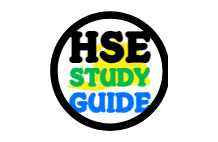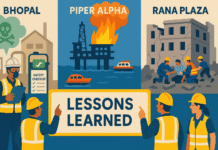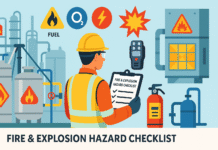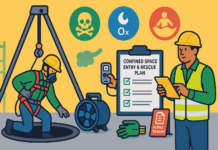
Site Housekeeping Activities HIRA (Hazard Identification and Risk Assessment)
Good housekeeping is the foundation of a safe and productive construction site. It involves keeping work areas clean, organized, and free of unnecessary materials or waste. Poor housekeeping can lead to slips, trips, falls, fire hazards, blocked emergency routes, and material damage.
Although often overlooked, site housekeeping is a critical safety function that must be integrated into daily operations through proper planning, monitoring, and risk management.
Objective of Site Housekeeping HIRA
- To identify hazards associated with poor housekeeping practices.
- To evaluate risks based on likelihood and potential consequences.
- To define and implement engineering, administrative, and PPE control measures.
- To ensure a clean, organized, and hazard-free workplace for all site personnel.
Scope
This HIRA covers:
- Collection, segregation, and disposal of site waste
- Handling and storage of materials and equipment
- Cleaning of access ways, staircases, platforms, and work areas
- Removal of debris, sharp objects, and unused construction materials
- Fire prevention through proper storage of flammables
- Housekeeping inspections and reporting
Step-by-Step HIRA for Site Housekeeping Activities
1. Activity Description
Housekeeping activities include routine cleaning, debris removal, waste segregation, pathway clearance, proper storage of tools and materials, and ensuring access to emergency exits.
2. Hazard Identification Table
| S. No. | Hazard | Potential Effects | Persons at Risk |
|---|---|---|---|
| 1 | Slips on wet or oily surfaces | Sprains, fractures, falls | All site workers |
| 2 | Trips over scattered materials or tools | Head injuries, twisted ankles | Workers, visitors |
| 3 | Accumulated debris or waste | Fire risk, blocked paths | Everyone onsite |
| 4 | Sharp objects (nails, glass, wires) | Cuts, puncture wounds | Housekeeping staff |
| 5 | Manual handling of bins and debris | Back injuries, muscle strain | Laborers |
| 6 | Improper disposal of flammable waste | Fire or explosion | Entire site crew |
| 7 | Obstructed emergency routes or fire exits | Delayed evacuation, entrapment | All personnel |
| 8 | Dust from sweeping or dry waste | Respiratory issues | Housekeeping workers |
| 9 | Rodent or insect infestations in unclean areas | Illness, contamination | All staff |
| 10 | Improper tool/equipment storage | Falling tools, trip hazards | General workforce |
3. Risk Assessment Matrix
Risk Rating = Likelihood (L) × Severity (S)
Scale: 1–5 for both L and S
| Hazard | Likelihood (L) | Severity (S) | Risk Rating | Risk Level |
|---|---|---|---|---|
| Slips on wet surface | 4 | 3 | 12 | High |
| Trips over materials | 4 | 2 | 8 | Medium |
| Debris accumulation | 3 | 4 | 12 | High |
| Sharp object injuries | 3 | 3 | 9 | Medium |
| Manual handling | 3 | 3 | 9 | Medium |
| Flammable waste | 2 | 5 | 10 | High |
| Blocked emergency routes | 3 | 5 | 15 | High |
| Dust inhalation | 3 | 3 | 9 | Medium |
| Pest infestation | 2 | 3 | 6 | Medium |
| Improper storage | 3 | 3 | 9 | Medium |
4. Control Measures
Engineering Controls:
- Provide non-slip floor coatings in wet-prone areas.
- Use storage racks and tool organizers to reduce clutter.
- Provide waste bins, containers, and skips for segregation and collection.
- Install clear floor markings for walkways, exits, and storage zones.
- Use covered disposal bins for flammable and hazardous waste.
Administrative Controls:
- Daily housekeeping schedule and cleaning checklist.
- Assign designated housekeeping teams or rotating crew duties.
- Toolbox talks on good housekeeping practices and waste disposal.
- Display signage for waste segregation: plastic, metal, general, hazardous.
- Conduct weekly inspections and audits of cleanliness and fire exits.
- Emergency route clearance to be checked and signed off daily.
Personal Protective Equipment (PPE):
- Cut-resistant gloves for handling debris and sharp items.
- Dust masks for sweeping and waste segregation.
- Safety goggles to protect eyes from dust or flying particles.
- Safety boots with steel toes and slip-resistant soles.
- High-visibility vests for identification during cleaning tasks.
5. Safe Work Procedure (SWP)
Before Housekeeping Tasks:
- Review housekeeping area and identify hazards.
- Ensure proper PPE is available and worn.
- Place caution signs if cleaning near pathways or wet floors.
- Clear the area of unnecessary personnel.
During Housekeeping:
- Segregate waste into labeled bins: recyclable, hazardous, scrap.
- Avoid overfilling bins; replace and dispose regularly.
- Do not sweep dry dust—use water spray or vacuum.
- Remove nails and sharp items using magnet bars or tongs.
- Lift using knees and hips; avoid twisting with heavy bins.
After Housekeeping:
- Ensure tools and materials are stored in their assigned places.
- Keep fire exits, stairways, and emergency routes free of obstruction.
- Dispose of waste in designated external areas or skips.
- Document any observed unsafe conditions or incidents.
6. Emergency Preparedness
- Fire extinguishers available near waste storage and high-risk zones.
- First aid kits for treating cuts, splinters, and abrasions.
- Eye wash stations for debris or chemical splash incidents.
- Pest control response in case of rodent or insect infestation.
- Maintain clear emergency exits and accessible muster points.
7. Roles and Responsibilities
| Role | Responsibility |
|---|---|
| Site Supervisor | Assign and monitor housekeeping tasks |
| Safety Officer | Conduct inspections and enforce compliance |
| Housekeeping Team | Perform scheduled cleaning and waste disposal |
| Laborers | Keep work zones tidy and report unsafe conditions |
| Site Engineer | Approve layout and storage locations |
| First Aider | Treat minor injuries and respond to emergencies |
Summary of Key Recommendations
- Establish a housekeeping plan and integrate into daily work routines.
- Maintain segregated bins for waste management.
- Mark and maintain clear walkways, fire exits, and storage zones.
- Assign accountability for each area’s cleanliness.
- Conduct toolbox talks focused on the importance of housekeeping.
- Ensure PPE usage and safe manual handling techniques.
- Implement visual management through signage, floor markings, and checklists.
- Conduct weekly audits and recognize clean zones with safety incentives.
Monitoring and Review
- Daily walkthroughs by supervisors to verify housekeeping status.
- Weekly waste reports and volume tracking.
- Corrective actions logged during inspections.
- Monthly review of slip/trip incident trends.
- Regular feedback sessions with workers to improve site cleanliness.
Conclusion
Good housekeeping is a core safety practice that significantly reduces the risk of accidents, improves productivity, and fosters a culture of responsibility. A clean site is a safe site — and this can only be achieved through structured hazard identification, risk control, routine checks, and workforce commitment.
With a systematic HIRA approach and diligent implementation of safety protocols, site housekeeping can be transformed from a basic task into a powerful preventive safety measure.
Tower Crane Operation HIRA (Hazard Identification and Risk Assessment)
Demolition Work HIRA (Hazard Identification and Risk Assessment)
Rebar Cutting and Bending HIRA (Hazard Identification and Risk Assessment)
Concreting and Formwork HIRA (Hazard Identification and Risk Assessment)
























